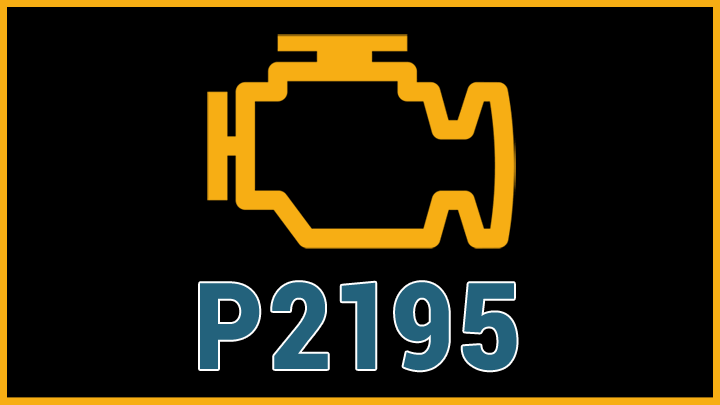Last Updated on October 5, 2022
Few things will stress you out more than a check engine light. But once you’ve pulled your heart out of your throat and checked what your vehicle’s check engine light means, you’re presented with a whole new list of questions.
What does this code mean, what causes it, and most importantly, how do you fix it? Well, if you have a code P2195, you’ve come to the right place. We’ll walk you through everything you need to know and have your vehicle back on the road in no time.
The good news is that you can usually fix a code P2195 for less than 40 bucks, which means you likely dodged a bullet with this one.
What Does Code P2195 Mean?
A code P2195 is an emissions-related code, more specifically, it’s telling you one of the oxygen sensors (bank 1, sensor 1) is registering a lean circuit. The same fault in the bank 1, sensor 2 location would issue a code P2270.
A lean circuit means that there isn’t enough fuel in the system – and the oxygen sensor circuit can tell you this by measuring the number of emissions coming out of the exhaust.
It knows your vehicle didn’t magically get better at reducing emissions, which means there isn’t enough fuel in the combustion chamber.
However, a code P2195 is registering a little more than just a lean circuit – it’s telling you that it’s stuck lean. That means the engine has tried adding more fuel to adjust to the circuit, and it hasn’t made a difference.
What that tells you is that there’s a problem somewhere in the circuit – which is why you have a code P2195.
Related: How to Locate the Correct O2 Sensor
Symptoms of Code P2195

If you have a code P2195, there likely won’t be a ton of noticeable symptoms – unless you’re looking closely for them. The most noticeable symptoms are going to be decreased engine performance and decreased fuel efficiency.
What happens is that your vehicle thinks everything is running too lean, so the ECM (Engine Control Unit) keeps dumping extra fuel into the engine. Of course, your engine doesn’t need extra fuel – it just doesn’t know how much of it the engine is burning.
This results in excessive fuel getting dumped into the combustion chamber, which is terrible for fuel-efficiency. Moreover, your engine optimizes performance to specific fuel levels. Without the sensor to let it know how everything is going, the engine will not perform at the highest possible levels.
See Also: ECM vs PCM vs ECU
Causes of Code P2195

#1 – Bad Oxygen Sensor
By far the most common cause of a code P2195 is a faulty oxygen sensor. If the sensor no longer adjusts and is stuck on a lean reading, it’s the perfect explanation for a code P2195. However, while that’s the most common cause, it’s not the only potential cause.
#2 – O2 Sensor Wiring Issue
Another option is that there’s an issue with the oxygen sensor wiring. It doesn’t matter if it’s doing everything it should if it can’t get a signal back to the PCM (Powertrain Control Module). From there, it could be a problem with the PCM.
#3 – Software Update Needed
The most common problem is that the PCM needs a software update – and if this is the case, you’ll need to take your vehicle to a dealership.
#4 – Faulty PCM
Finally, while it’s extremely unlikely, there could be an underlying problem with your vehicle’s PCM that a software update can’t fix. If this is the case, your repairs will be extremely expensive, but it’s also a little more serious, and you’ll need to address it sooner.
Is Code P2195 Serious?
No, a code P2195 isn’t usually all that serious. But in the likely event that it’s nothing more than a faulty oxygen sensor, it can be cost-effective to repair it as soon as possible.
That’s because you can replace an oxygen sensor for about $20 to $40, and it won’t take long for the decreased fuel efficiency to become more costly than the repair!
However, that’s IF the oxygen sensor is the issue. If the problem is with the PCM, the decreased engine performance can result in more severe consequences. Furthermore, anytime you have a check engine light, it prevents you from seeing if another issue crops up.
That’s because your vehicle would alert you to a different problem through a check engine light – and since you already have one, you’ll have no idea you should get the codes read again – which means you might have a more serious problem and not even know about it!
How to Fix

Typically, all you need to do to fix a P2195 engine code is to replace or clean the oxygen sensors. However, if that doesn’t fix your problem, check out the wiring. The most common location for a wiring issue is right around the oxygen sensor, as this is where it’s most exposed to the elements.
If everything checks out there, you need to check out the PCM. This is usually above a DIY mechanic’s skillset – so there’s a good chance you’ll need to take it to a repair shop.
But if you do know what you’re doing and own an OBD II diagnostic tool, there are several tests you can run to verify that everything is working the way it should with the oxygen sensors before jumping to the PCM.
Finally, if the problem resides with the PCM, you’re going to need to take your vehicle to a dealership so they can check for software updates and potentially replace your PCM.
If your vehicle needs a new PCM, the dealership should complete this job too because they’ll need to flash it to your specific vehicle.




